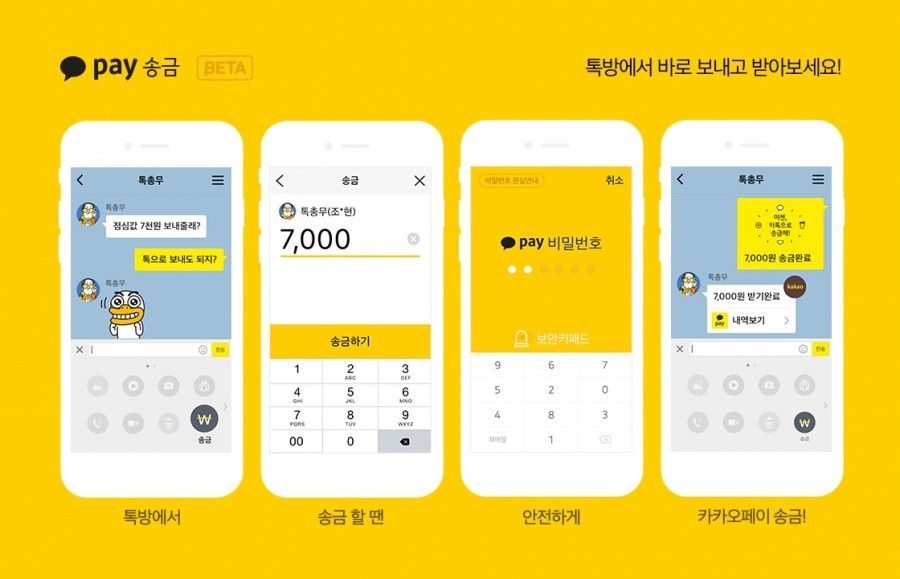Kakao Talk
Korea's Multi-functional Messenger Giant - A Review
The Reigning Champion of Korean Communication
In the vibrant digital landscape of the 21st century, where instant messaging plays a pivotal role in connecting individuals across the globe, each region has its reigning champion. While international players like WhatsApp and Telegram might be household names in many parts of the world, South Korea finds its digital pulse synchronized with KakaoTalk. This messaging titan, endearingly termed 'KaTalk', has over the years become more than just a chat app — it's now an emblem of modern Korean culture.
Emerging just over a decade ago, KakaoTalk has intertwined itself into the very fabric of Korean daily life. What makes it stand out is not just its immaculate messaging capabilities but the sheer breadth of services and features that have been incorporated into its framework over the years.
KakaoTalk's Humble Beginnings
It was 2010 when Kakao Corp launched KakaoTalk. Designed as a response to the exorbitant fees associated with SMS services at the time, KakaoTalk aimed to be an affordable and efficient messaging alternative. It capitalised on the burgeoning smartphone trend in Korea, swiftly establishing itself as the go-to platform for free, fast, and dependable communication. The ease of use and the promise of free messaging led to its rapid adoption, making it a favorite not only among the youth but also among older generations.
As smartphones became more sophisticated, so did KakaoTalk. Features like group chats, voice notes, and video calls were introduced, further cementing its position as Korea's top communication tool. The evolution had just begun.
From Messenger to Ecosystem: The Evolution of KakaoTalk
KakaoTalk's brilliance shines through its adaptability. Recognizing the diverse needs of its user base, it ventured beyond mere messaging. Multimedia sharing, digital stickers, and a personal news feed akin to Facebook, termed 'Kakao Story', were integrated. But this was just the tip of the iceberg. As the digital age in Korea matured, KakaoTalk seamlessly introduced a myriad of life services, from hailing cabs with Kakao T and making digital payments with Kakao Pay, to even dabbling in banking.
This continuous integration transformed KakaoTalk from a mere chat app to an all-encompassing digital hub. Today, it's almost challenging to navigate daily life in Korea without accessing some facet of KakaoTalk. Whether it's booking a movie ticket, paying a bill, or just sharing a moment with friends, KakaoTalk is at the heart of it all.
Comparing Giants: KakaoTalk vs. WhatsApp and Telegram
At face value, KakaoTalk shares many similarities with international counterparts like WhatsApp and Telegram. Messaging, group chats, voice, and video capabilities are standard across the board. However, the distinction arises in the additional layers that KakaoTalk offers. Unlike WhatsApp and Telegram, which maintain their primary identity as communication tools, KakaoTalk has seamlessly integrated various services, blurring the lines between messaging, social networking, and digital services.
While the convenience is unparalleled, there's also a cultural element at play. Just as hallyu waves have swept the world with Korean music, dramas, and more, KakaoTalk, with its uniquely Korean digital offerings, stands as a testament to Korea's tech-forward ethos, differentiating itself in the crowded messaging app market.
Korea's Answer to China's Digital Juggernaut: KakaoTalk and WeChat
KakaoTalk's trajectory is reminiscent of China's WeChat. Both began with simple messaging roots but evolved to become digital powerhouses in their respective nations. WeChat’s 'Mini Programs' revolutionized the app experience by bringing a plethora of services under one umbrella. KakaoTalk, not to be outdone, has matched this with its impressive suite of services, from shopping to banking, ensuring users rarely need to venture outside its ecosystem.
While both apps cater to their cultural contexts, what's evident is their shared vision of a consolidated digital experience. They've transformed from mere messengers to lifelines in their respective digital landscapes, driving forward the concept of an integrated app ecosystem.
The Expansive World of Kakao Services

KakaoTalk, as the nerve center of Kakao Corp's diverse portfolio, offers an astonishing array of services. While its roots lie in messaging, it has expanded to touch almost every aspect of daily life in South Korea. Let's delve into the various services under the Kakao umbrella:
- KakaoTalk (KaTalk): The core messaging service, it supports text, voice, and video calls, and has recently added features like KakaoTV, where users can stream and watch videos together in real-time.
- KakaoPay: An integrated mobile payment and digital wallet service. Users can send money, pay bills, and even invest in financial products.
- Kakao T: A transport-focused suite that includes KakaoTaxi for hailing cabs, KakaoBus to check bus schedules, KakaoNavi for navigation, and KakaoParking to locate and pay for parking spaces.
- KakaoMap: A detailed and comprehensive map service tailored for South Korea, offering navigation, public transport routes, and local business listings.
- KakaoStory: A personal news feed where users can share moments, somewhat similar to Facebook's timeline.
- KakaoMusic: An integrated music streaming platform where users can discover, listen to, and share their favorite tunes.
- KakaoBank: A digital-first banking service offering a range of financial products from loans to insurance.
- KakaoPage & KakaoWebtoon: Platforms where users can access and enjoy webtoons, novels, and other digital content.
- KakaoFriends: A line of original characters derived from KakaoTalk emojis, this has grown into a full-fledged brand with merchandise, games, and even theme cafes.
- KakaoGames: A platform for discovering and playing mobile games.
- KakaoHairshop: A reservation service for hair salons and beauty consultations.
- KakaoStyle: A fashion shopping platform showcasing the latest trends.
- KakaoTV: A video content platform ranging from live streams to on-demand shows.
- KakaoEnterprise: Business solutions like KakaoWork for communication and KakaoMail for email services.
- KakaoShopping: An integrated shopping platform for a wide range of products.
The brilliance of Kakao's ecosystem lies in its interconnectedness. Each service is seamlessly linked, allowing users to, for instance, chat about a restaurant on KakaoTalk, use KakaoMap to find its location, KakaoPay to split the bill, and then leave a review on KakaoPlace.
KakaoPay: Revolutionizing Payments in Korea

In the realm of digital finance, KakaoPay has emerged as a game-changer in South Korea. As an offshoot of Kakao Corp., KakaoPay carries the innovative spirit of its parent company, venturing beyond mere mobile messaging to revolutionize the financial sector. Built into the ubiquitous KakaoTalk app, KakaoPay offers a seamless experience that's reshaping how Koreans transact daily.
The Working Mechanism
To start with KakaoPay, users have to register a valid bank account in Korea. Once linked, they can effortlessly top up their KakaoPay wallet or directly draw funds from the connected account. With a user-friendly interface, people can pay for goods and services, split bills, transfer money, and even invest in diverse financial products. QR codes, often used at local businesses, make the process even more streamlined, allowing users to scan and pay within seconds.
Comparing KakaoPay with Apple Pay
While both KakaoPay and Apple Pay operate in the realm of digital wallets and mobile payment systems, there are distinct differences between them:
- Integration with Messenger App: KakaoPay is deeply integrated into KakaoTalk, Korea's leading messaging app. This fusion ensures that almost every KakaoTalk user has easy access to KakaoPay, creating an enormous potential user base. In contrast, Apple Pay is integrated into the Apple ecosystem, reliant on users owning an Apple device.
- Service Range: While Apple Pay primarily focuses on facilitating payments – be it in-store, in-app, or online – KakaoPay goes beyond. It ventures into the realms of personal finance, allowing users to invest, manage funds, and even take out loans.
- Regional Focus vs. Global Reach: KakaoPay is tailored for South Korea, with a deep understanding of local customs, preferences, and regulations. Its services and promotions are highly localized. Apple Pay, on the other hand, is a global product available in numerous countries, often adopting a one-size-fits-all approach.
- Customization and Local Partnerships: Given its localized approach, KakaoPay often collaborates with local businesses for promotions, deals, and integrations. Apple Pay, while partnering with various banks and institutions globally, may not have the same level of localized deals or offers.
- User Experience: Both platforms prioritize user experience. KakaoPay, with its integration into KakaoTalk, ensures a seamless transition between chatting and transacting. Apple Pay is renowned for its simplistic design and ease of use, especially with the tap-to-pay feature using NFC technology.
KakaoPay represents the epitome of what a localized financial solution should look like. It's a system built around the unique needs and behaviors of its primary user base. While Apple Pay offers a global solution with its own set of advantages, KakaoPay's deep understanding of its home turf gives it an edge in South Korea. Whether you're team KakaoPay or Apple Pay, there's no denying that the future of finance is becoming increasingly digital and integrated.
KakaoTaxi: The Korean Ride-Hailing Phenomenon
KakaoTaxi has become synonymous with hailing a cab in modern South Korea. Gone are the days of standing on sidewalks, arm outstretched, waiting for an available taxi to pass by. With the advent of KakaoTaxi, integrated within the omnipresent KakaoTalk app, summoning a taxi is as easy as sending a message. This service has not only made life incredibly convenient for passengers but has also revolutionized the taxi industry in Korea. For taxi drivers, KakaoTaxi acts as a continuous beacon, directing them towards potential customers and ensuring minimal downtime. This efficient connection between passengers and drivers reduces the uncertainty of hailing taxis, especially during peak hours or in less busy areas.
But Kakao's innovation doesn't stop there. Recognizing the increasing demand for quick, reliable delivery services, Kakao introduced the Kakao Quick service. This ingenious solution allows users to request pickups of items and ensures their prompt delivery to specified locations. Whether it's a forgotten laptop, a bouquet of flowers, or a crucial document, Kakao Quick bridges the gap between sender and recipient. The backbone of this service are the dedicated individuals who have registered to be part of this delivery network. They act as the lifeline, ensuring goods are transported safely, efficiently, and punctually. With services like these, Kakao continues to reaffirm its commitment to making everyday Korean life more connected and convenient.
The Other Side of the Coin: KakaoTalk’s Drawbacks
Despite its dominance, KakaoTalk is not without its challenges. Over the years, concerns regarding privacy have surfaced, particularly pertaining to the storage of messages on its servers. While measures have been taken to address these concerns, lingering doubts persist among a segment of users. Furthermore, KakaoTalk's vast array of services, while beneficial to many, can feel cluttered and overwhelming for newcomers or those who prefer a streamlined messaging experience. The challenge for KakaoTalk lies in balancing its multifaceted offerings while maintaining user trust and simplicity.
KakaoTalk's journey from a simple messaging tool to a digital juggernaut exemplifies the transformative power of technology when tailored to meet the evolving needs of a community. Its deep roots in Korean society and continuous innovations make it an app to watch in the ever-evolving world of digital communication.

